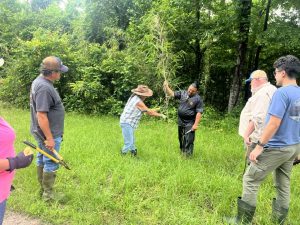Co-authors: Meg Woods, Parker King and Katya Menkina

On April 14, our CONSERVE team had the extraordinary opportunity to invite the Jena Band of Choctaw Indians from Louisiana to help thin native rivercane stands in Tuscaloosa, Alabama. Thinning native cane stands is vital to the health and resiliency of the cane stand ecosystem. The effort was organized by CONSERVE director Michael Fedoroff, and together with the CONSERVE team and Jena Band, over 500 stalks of native rivercane were sustainably harvested from a patch near the Black Warrior River. This collaboration was not just about good ecosystem stewardship; it was also a convergence of cultures to preserve a timeless art and traditional relationship with the land.
Rose Fisher and Casey Bigpond of the Jena Band of Choctaw led the harvest efforts. Fisher has devoted her life to safeguarding traditional basket weaving techniques and passing them on to future generations. Bigpond serves as the cultural program director for the Jena Band of Choctaw. He is helping organize a workshop with Fisher to create a “Burden Basket,” a project Fisher has envisioned for decades. For this, cane is required that can be utilized for basket weaving. Lillie Williamson, the EPA director for the Jena Band’s environmental department and a dedicated student of Fisher, a renowned indigenous weaving artist, also participated.
Our team thoroughly enjoyed working with Williamson, Fisher and the tribal members. They taught us the intricacies of collecting and preparing rivercane, a skill critical for crafting traditional baskets. It was an honor to contribute to this historical project, gathering materials for a Burden Basket — a significant cultural artifact used by their ancestors during the Trail of Tears. In addition to the rivercane, we captured numerous photos and videos of our collaborative afternoon. These moments highlight the rivercane’s journey from the ecosystem to its integral role in the cultural heritage of the Jena Band. It was an enriching and educational experience, building stronger relationships with our tribal partners.
Meeting the Jena Band members, including Williamson and tribal council member Lacy McGuffee, was a unique experience. McGuffee mentioned that the chief regretted her absence due to interviews, yet the support from the council was heartening. Typically, council member’s political responsibilities do not allow time for participating in hands-on activities like gathering cane. This demonstrated the Jena Band’s deep connection and relationship with rivercane.
Before we began, Fisher and Williamson briefed us on the importance of cutting the cane properly. They explained the signs of readiness in the cane, like thickness and color changes. Williamson shared that this was their largest-scale cane gathering, yet their past experiences, such as collecting 1,500 palmettos for a Choctaw house in one morning, showcased their efficiency and dedication.
Engaging with tribal elders like Fisher was enlightening. She shared stories of the Jena Band’s history, weaving techniques, and her personal struggles in passing on this art to younger generations. The process of making a basket is labor-intensive and dangerous due to the cane’s sharpness. The Burden Basket holds profound historical significance, representing the resilience of their ancestors during the Trail of Tears and featuring prominently on the Jena Band’s emblem. Fisher expressed both eagerness and trepidation, as completing this project would be a monumental personal achievement.
Our time with the Jena Band was impactful for both parties. They expressed interest in future collaborations, including a potential restoration project on their property and another rivercane event in Tuscaloosa. The partnership and shared knowledge made the experience invaluable. The CONSERVE team was amazed by the abundance of rivercane so close to campus. CONSERVE member Dr. Michael McKain led us through the dense growth, teaching us to differentiate between invasive bamboo and native rivercane. Documenting this journey with drones and cameras, we captured the essence of our collaboration. The day passed quickly, and we met the rivercane stewardship goal. This experience was a profound learning opportunity for the CONSERVE team to understand how to properly thin a cane patch for ecosystem management, and we were honored to have played a part in helping the Jena Band achieve their dream of creating the Burden Basket.